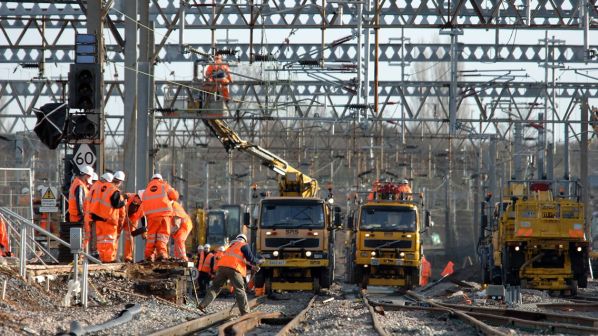A group of 17 organisations representing the industry across Britain have written to the secretary of state for transport, Mr Grant Shapps, calling for the introduction of a rolling programme of electrification in order to support the government’s goal to remove diesel trains from the British rail network by 2040.
The letter was sent following the publication of a new report, Why Rail Electrification?, which complements the interim programme business case of infrastructure manager Network Rail’s (NR) Traction Decarbonisation Network Strategy (TDNS) by explaining why large-scale electrification is required to decarbonise the network.
The report was produced by Mr Garry Keenor, group engineer (OLE) at Atkins, Mr Noel Dolphin, head of UK Projects for Furrer+Frey, Mr Paul Hooper, technical director at Atkins, and Mr David Shirres, editor of Rail Engineer, in collaboration with the Rail Industry Association (RIA).
The report says that a modal shift of 4% of passengers and 4% of freight transport to rail would save more carbon than the rail sector’s current total emissions. Achieving this would require high-performance traction coupled with capacity enhancement.
Current battery and hydrogen trains require 21 and 12 times the storage volume of a diesel tank, respectively, the report says, which means trains that supply electricity from the national grid to their motors will always provide the most powerful and efficient railway traction, with the lowest operating cost.
The TDNS concluded that the rail traction mix required to achieve net-zero emissions should be: electrification - 86%; hydrogen - 9%; and batteries - 5%. However, more battery and hydrogen trains will be required before 2050 as much of the current diesel fleet will be life-expired before then.
The report adds that more electrification is required to allow electric trains to replace diesel locomotives used to haul freight. Currently, electricity provides only 4% of Britain’s rail freight’s energy requirement, compared with 56% in continental Europe. Studies have shown that an electrification programme of around 10% of that recommended by TDNS would enable about 70% of rail freight to be electrically hauled.
The report says electrification is also a good investment, both financially and in respect of carbon, as the emissions from the electrification work are recouped from traction carbon savings within a few years. Other benefits include:
- typical lifetime vehicle operational savings of £2.5m
- increased revenue and better utilisation, thanks to journey time reductions offered by greater speeds and higher acceleration rates
- greater freight train speeds and tonnage, and
- increased capacity and timetable resilience.
With a number of recent schemes completed significantly over budget, the report says it is understandable that some might consider electrification to be unaffordable, but adds that a lot has been done to learn from these costly schemes.
The RIA’s Electrification Cost Challenge Report, published in March 2019, found that with only limited electrification over the preceding 20 years, the industry had largely lost its skills base when the schemes were launched,. It then took time to develop the skills and capability required to deliver the large electrification programme. Since then, innovations have also reduced electrification costs and have allowed more recent schemes to be delivered in a cost-effective manner.
In order to retain skills and to continue to deliver ensure electrification efficiently, the report recommends a steady rolling programme which, given its size, would need to be launched now in order to meet the government’s goal of being net-zero by 2050. The report also says that hard-won lessons will be lost unless further electrification schemes are approved and started soon.
The report says that hydrogen and battery systems will not render electrification redundant as they are developed further, as hydrogen trains are inherently less efficient than electric trains, due to the physical properties of the gas. While expert opinion predicts that battery capability might double by 2035, the report says this is only likely to affect the proportion of battery and hydrogen trains required without affecting the overall requirement for electrification.
“The laws of nature make electrification a future-proofed technology that is a good investment, offering large passenger, freight, and operational benefits,” the report says. “Furthermore, railways cannot achieve net-zero carbon emissions without a large-scale electrification programme.”
Signatories of the letter sent to the secretary of state for transport include:
- Campaign for Better Transport
- Campaign to Electrify Britain’s Railway
- Civil Engineering Contractors Association
- Electrical Contractors Association
- Institution of Mechanical Engineers
- Logistics UK
- National Skills Academy for Rail
- Northern Rail Industry Leaders
- Permanent Way Institution
- Rail Alliance
- Rail Forum Midlands
- Rail Delivery Group (RDG)
- Rail Freight Group
- Railfuture
- Railway Industry Association (RIA)
- Rail Safety and Standards Board (RSSB), and
- Urban Transport Group.

